-

新人教版高中英语必修3Unit 5 The value of money-Reading and Thinking教学设计二
? Could you offer me some kind of work here?? I don’t want your charity, I just want an honest job.? Careless: I landed in Britain by accident.Step 7:Consolidation.? Find Henry? Roderick and Oliver were I .making a bet when they saw Henry, a poor young man. ? Know Henry? About a month ago, Henry was sailing and later he found himself carried out to sea by a strong wind. Fortunately, he 2.was spotted by a ship. And it was the ship that brought him to 3.England? Offer money to Henry ? Oliver and Roderick gave Henry a letter and told him that there was money in it. They 4.persuaded him to accept it, and made him 5.promise that it wouldn't be opened until 2 o'clock.Step 8:Language pointsa large amount of: a large quantity of; a great deal ofe.g. They bought a large amount of furniture before they moved their new house.make a bet: make an arrangement to risk money, etc. on an event of which the result is doubtful.e.g. We made a bet on the result of the match.permit sb to do something: allow somebody to do somethinge.g. My mother doesn’t permit me to ride in the street after it rained.by accident: as a result of chancee.g. I only found it by accident.stare at: look at somebody or something with the eyes wide open in a fixed gaze( in astonishment, wonder, fear, etc)to be honest: to tell you the truth; to be franke.g. To be honest, I don’t think we have a chance of winning.Step7 Homework:What do you think will happen to Henry? Will the bank-note help him or get him into trouble?

新人教版高中英语必修3Unit 1 Festivals and Celebrations-Reading for writing教学设计二
Step 3 Analyzing article structureActivity 31. Teachers raise questions to guide students to analyze the chapter structure of this diary and think about how to describe the festival experience. (1)What should be included in the opening/body/closing paragraph(s)?(2)How did the writer arrange his/her ideas?(3)What kind of interesting details did the writer describe?(4)How did the writer describe his/her feelings/emotions during the event?2. Students read and compare the three sentence patterns in activity 2. Try to rewrite the first paragraph of the diary with these three sentence patterns. After that, students exchange corrections with their partners. Such as:●This was my first time spending three days experiencing the Naadam Festival in China’s Inner Mongolia Autonomous Region and it was an enjoyable and exciting experience. ●I'll never forget my experience at the Naadam Festival because it was my first time to watch the exciting Mongolian games of horse racing, wrestling, and archery so closely. ●I'll always remember my first experience at the Naadam Festival in China’s Inner Mongolia Autonomous Region because it was so amazing to spend three days witnessing a grand Mongolian ceremony. Step 4 Accumulation of statementsActivity 41. Ask the students to read the diary again. Look for sentences that express feelings and emotions, especially those with the -ing form and the past participle. Such as:● …horse racing, wrestling, and archery, which are all so exciting to watch. ● some amazing performances● I was surprised to see…● I was a little worried about. . . ● feeling really tiredOther emotional statements:●I absolutely enjoyed the archery, too, but the horse races were my favourite part. ●I'm finally back home now, feeling really tired, but celebrating Naadam with my friend was totally worth it. ●He invited me back for the winter to stay in a traditional Mongolian tent and cat hot pot. I can’t wait!2. In addition to the use of the -ing form and the past participle, the teacher should guide the students in the appreciation of these statements, ask them to memorize them, and encourage them to use them reasonably in writing practice.
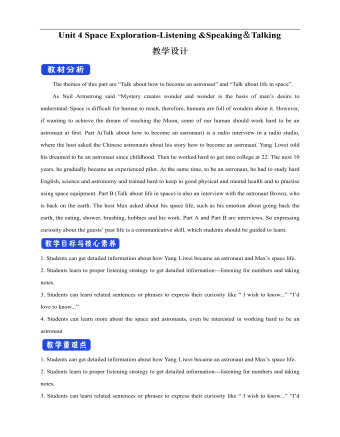
新人教版高中英语必修3Unit 4 Space Exploration-Listening&Speaking&Talking教学设计二
The themes of this part are “Talk about how to become an astronaut” and “Talk about life in space”. As Neil Armstrong said “Mystery creates wonder and wonder is the basis of man’s desire to understand. Space is difficult for human to reach, therefore, humans are full of wonders about it. However, if wanting to achieve the dream of reaching the Moon, some of our human should work hard to be an astronaut at first. Part A(Talk about how to become an astronaut) is a radio interview in a radio studio, where the host asked the Chinese astronauts about his story how to become an astronaut. Yang Liwei told his dreamed to be an astronaut since childhood. Then he worked hard to get into college at 22. The next 10 years, he gradually became an experienced pilot. At the same time, to be an astronaut, he had to study hard English, science and astronomy and trained hard to keep in good physical and mental health and to practise using space equipment. Part B (Talk about life in space) is also an interview with the astronaut Brown, who is back on the earth. The host Max asked about his space life, such as his emotion about going back the earth, the eating, shower, brushing, hobbies and his work. Part A and Part B are interviews. So expressing curiosity about the guests’ past life is a communicative skill, which students should be guided to learn.1. Students can get detailed information about how Yang Liwei became an astronaut and Max’s space life.2. Students learn to proper listening strategy to get detailed information---listening for numbers and taking notes.3. Students can learn related sentences or phrases to express their curiosity like “ I wish to know...” “I’d love to know...”4. Students can learn more about the space and astronauts, even be interested in working hard to be an astronaut
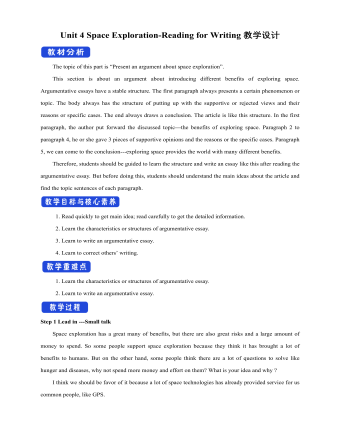
新人教版高中英语必修3Unit 4 Space Exploration-Reading for Writing教学设计二
⑦在我看来, 探索太空是值得的。As far as I am concerned, it is worthwhile to explore the space.Step 10 Writing---draftRecently, students in our class have had heated a discussion on whether space is worth exploring. Students hold different ideas about it.30% of us think space exploration is not worthwhile. They think space is too far away from us and our daily life and is a waste of money. And the money spent on space exploration can be used to solve the earth’s problems such as starvation and pollution.On the other hand,70% think space is worth exploring because we have benefited a lot from it,such as using satellites for communication and weather forecast. What’s more,with further space research,we may solve the population problem by moving to other planets one day. Also,space research will enable us to find new sources to solve the problem of energy shortages on the earth.As far as I am concerned, it is worthwhile to explore the space. Not only can it promote the development of society but also enrich our life. Step 11 Pair workExchange drafts with a partner. Use this checklist to help your partner revise his/her draft.1.Does the writer explain why he/she changed/wanted to change?2.Does the writer tell how the changes have improved or will improve his/her life?3.Is the text well-organised?4.Does the writer use words and expressions to show similarities and differences?5.Are there any grammar or spelling errors?6.Does the writer use correct punctuation?
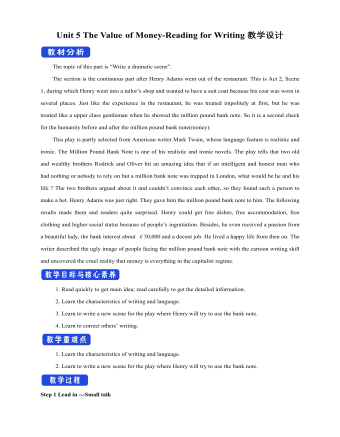
新人教版高中英语必修3Unit 5 The Value of Money-Reading for Writing教学设计二
2. 您能看到, 我头发太长了。You can see that my hair is much too long.3. 无论什么时候, 只要您想回来就回来。Please come back whenever you want.4. 您仅有很少的头发要理! You only have too little hair to cut !5. 为您服务是我的荣幸!It is my honour to serve you!Step 9 Writing(Henry is walking down the street when he sees a sign for a place that cuts hair. He decides to have it cut. )H=Henry B=BarberH: Good afternoon, I’d like to have my hair cut, if I may. (The barber looks at Henry’s hair and continues cutting another man’s hair. ) Er, I’d really like a haircut. As you can see it’s much too long. B: (in a rude manner) Yes, I can see that. Indeed, I can. H: Fine, well, I’ll have a seat then. (He sits in one of the barber’s chairs. The barber turns to look at Henry. )B: It’s quite expensive here, you know! Are you sure you can afford it?H: Yes. I think so. (After his hair is cut, the barber tells Henry how much he must pay. Henry shows the barber the bank note. )B: Why Mr. . . (looks shocked)H: Adams. Henry Adams. I’m sorry. I don’t have any change. B: Please don’t worry! (wearing a big smile) Nothing to worry about! Nothing at all! Please come back whenever you want, even if you only have too little hair to cut! It will be my honour to serve you!Step 10 Pair workExchange drafts with a partner. Use this checklist to help your partner revise his/her draft.1. Are all the elements of a play included and in good order ?2. Do the character use suitable language ?3. Are the stage directions clear and useful ?4. Is the plot clear and exciting enough ?

人教A版高中数学必修二简单随机抽样教学设计
知识探究(一):普查与抽查像人口普查这样,对每一个调查调查对象都进行调查的方法,称为全面调查(又称普查)。 在一个调查中,我们把调查对象的全体称为总体,组成总体的每一个调查对象称为个体。为了强调调查目的,也可以把调查对象的某些指标的全体作为总体,每一个调查对象的相应指标作为个体。问题二:除了普查,还有其他的调查方法吗?由于人口普查需要花费巨大的财力、物力,因而不宜经常进行。为了及时掌握全国人口变动状况,我国每年还会进行一次人口变动情况的调查,根据抽取的居民情况来推断总体的人口变动情况。像这样,根据一定目的,从总体中抽取一部分个体进行调查,并以此为依据对总体的情况作出估计和判断的方法,称为抽样调查(或称抽查)。我们把从总体中抽取的那部分个体称为样本,样本中包含的个体数称为样本量。
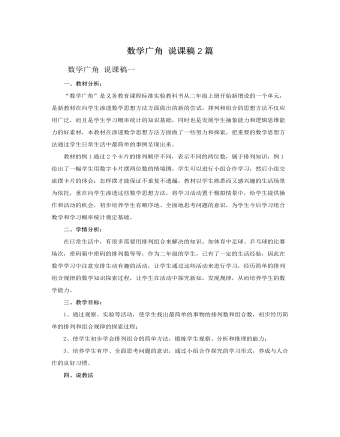
人教版新课标小学数学二年级上册数学广角 说课稿2篇
对比分析为什么刚才咱们从不同的3个数字中选出两个,可以摆成6个不同的两位数,而现在三个同学每两个握一次手,就一共只握了3次呢?(学生讨论,发表意见)(握手不存在调换位置的情况,跟顺序无关,而排列数,位置调换就变成另一个数,与顺序有关。)三、实践应用,巩固新知师引导:同学们今天说得太精彩了!那我们就进数学广角痛痛快快地玩玩吧!(出示课件)问:进去吗?(再次打开课件,欣赏)1、快乐狗活动室(练习二十三第2题)质疑:咦,机灵猫,兰兰他们去哪了?呵,机灵猫猫想要运动运动,就来到了快乐狗活动室。(课件展示)机灵猫就是机灵猫,看他们打球还想到问题了:如果每两个人打一场乒乓球比赛,他们三人一共要打多少场比赛呢?谁能很快说出来!(学生分析,指名说说)2、小喜鹊超市(练习二十三第1题)
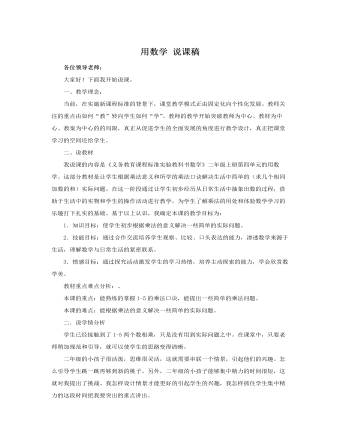
人教版新课标小学数学二年级上册用数学 说课稿
以引导学生的饿练习兴趣,再让学生根据画面内容提出用乘法计算的问题,之后再让学生小组合作交流。然后汇集学生提出的问题,并和学生一起评价提出的问题。再让学生独立解决提出的用乘法计算的问题。并在组内进行交流评价。让学生积极主动地经历观察发现问题——提出问题——解决问题的过程,感受数学在日常生活中的作用,获得一些初步的提出用乘法计算的问题和解决问题实践活动的经验。5,让学生充分说说你有什么收获。整堂课的设计,着重体现了以学生为主体,教师是学生的组织者、引导者、合作者。在整个教学过程中,主要让学生乐学,爱学,使学生从学会变成“我要学,我会学,”激发了学生的学习兴趣,培养其探究能力和自主学习的意识,同时,在不断运用数学知识解决身边的数学问题中,逐步发展学生的应用意识。
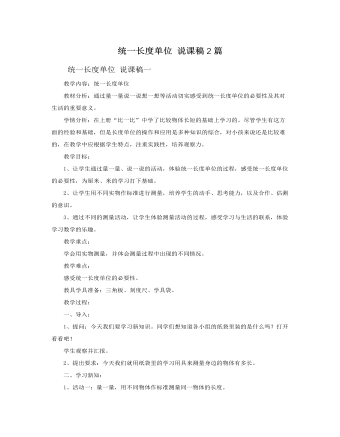
人教版新课标小学数学二年级上册统一长度单位 说课稿2篇
教学内容:统一长度单位教材分析:通过量一量说一说想一想等活动切实感受到统一长度单位的必要性及其对生活的重要意义。学情分析:在上册“比一比”中学了比较物体长短的基础上学习的。尽管学生有这方面的经验和基础,但是长度单位的操作和应用是多种知识的综合,对小孩来说还是比较难的,在教学中应根据学生特点,注重实践性,培养观察力。教学目标:1、让学生通过量一量、说一说的活动,体验统一长度单位的过程,感受统一长度单位的必要性,为厘米、米的学习打下基础。2、让学生用不同实物作标准进行测量,培养学生的动手、思考能力,以及合作、估测的意识。3、通过不同的测量活动,让学生体验测量活动的过程,感受学习与生活的联系,体验学习数学的乐趣。
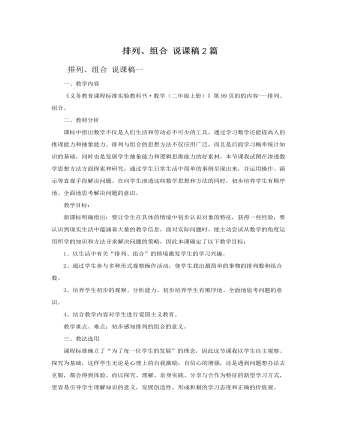
人教版新课标小学数学二年级上册排列、组合 说课稿2篇
活动四:握手游戏这一环节,我先和一个学生握手,并用甲--乙表示我和刚才那个学生,中间用连线的方式数出我们握了一次手。随后,问题提升:假如有三个小朋友,每两人只握一次手,共握几次手?我先让学生猜想会有几次?然后请三个小朋友上台操作验证,并用数学符号代表三个小朋友,请一个小朋友用连线的方式数。最后提问:同样是3,为什么3个数字可以摆6个两位数,而三个人却只能握三次手?让小朋友通过感悟握手是两个人完成的行为,与位置无关,初步理解简单事物排列与组合的不同。活动五:搭配衣服这一环节,我让学生自主连线搭配,然后请一生上台边连线边介绍,让学生用有序思考的方式解决生活中的实际问题。活动六:买东西这一环节,我让学生在仔细读题的基础上,通过同桌讨论,有序地总结出四种不同的付钱方式,可以从5角考虑起,也可以从1角考虑起。
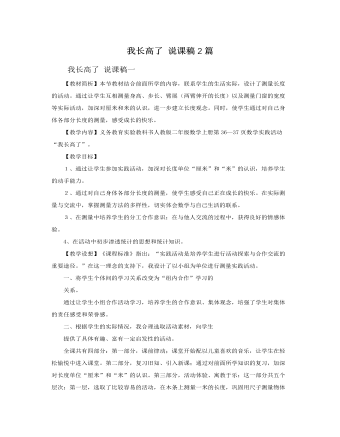
人教版新课标小学数学二年级上册我长高了 说课稿2篇
【教学设想】《课程标准》指出:“实践活动是培养学生进行活动探索与合作交流的重要途径。”在这一理念的支持下,我设计了以小组为单位进行测量实践活动。一、将学生个体间的学习关系改变为“组内合作”学习的关系。通过让学生小组合作活动学习,培养学生的合作意识、集体观念,培强了学生对集体的责任感受和荣誉感。二、根据学生的实际情况,我合理选取活动素材,向学生提供了具体有趣、富有一定启发性的活动。全课共有四部分:第一部分,课前律动;课堂开始配以儿童喜欢的音乐,让学生在轻松愉悦中进入课堂。第二部分,复习旧知、引入新课;通过对前面所学知识的复习,加深对长度单位“厘米”和“米”的认识。第三部分,活动体验、寓教于乐;这一部分共五个层次;第一层,选取了比较容易的活动,在木条上测量一米的长度,巩固用尺子测量物体长度的方法;第二层,小组分工合作测量与同学们朝夕相处的课桌的长、宽、高这一实际问题,渗透了合作方法;
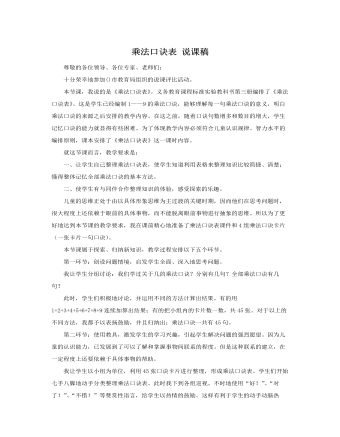
人教版新课标小学数学二年级上册乘法口诀表 说课稿
1、横着看乘法口诀表的规律。(1)第几行就是几的乘法口诀。(2)几的口诀就有几句。(3)第一句都从一开始,几的口诀到几为止。2、竖着看乘法口诀表的规律。(1)从第一竖行到第九竖行的口诀句数是从9——1的顺序出现的。(2)第一竖行是“一个几”,第二竖行是“两个几”……第几竖行就从“几”开始。(3)每一竖行都是到9为止。归纳出乘法口诀表规律后,我让集体分别按横行、竖行各读一遍口诀表。增加学生记忆乘法口诀表。第四环节:利用教学内容渗透思想教育。激发学生热爱科学的激情。我向学生说明:乘法口诀在我国两千多年前就有了。那时是从“九九八十一”开始的,所以也叫“九九歌”。七百多年前才倒过来,从“一一得一”开始。第五环节:布置作业。用自己喜欢的方式背诵乘法口诀表。
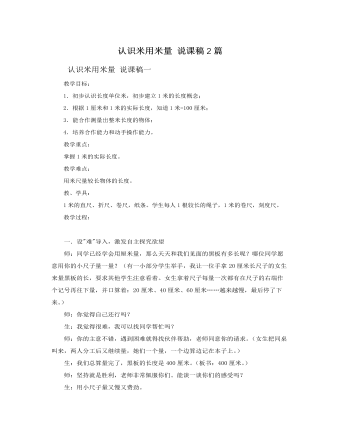
人教版新课标小学数学二年级上册认识米用米量 说课稿2篇
学情分析:本节课的教学内容是长度单位米,。尽管学生有这方面的经验和基础,但是长度单位米的建立还是比较难的,在教学中应根据学生特点,通过实践操作活动建立1米的观念。教学目标:1、使学生认识长度单位米,初步建立1米的长度观念,并学会用米测量物体的长度。知道1米=100厘米。2、培养学生观察能力、动手操作能力、空间想象能力和团结合作意识。教学重点:使学生认识长度单位米,初步建立1米的长度观念。知道1米=100厘米。教学难点:在实际操作过程中用米测量物体的实际长度。教具学具准备:米尺、学生尺、10厘米长的纸条、绳子等教学过程:一、创设情景,引起认知冲突。师:同学们,上节课我们学习了用什么作单位去量物体的长度?(厘米)上节课的内容大家都掌握得不错,谁能用学过的知识帮老师量量黑板的长?

小学数学人教版二年级上册《数学广角——搭配》说课稿
一、教材及学情分析“数学广角”是新教材在向学生渗透数学思想方面做出的新尝试。本课内容重在向学生渗透简单的排列组合的数学思想方法,并初步培养学生有顺序地、全面地思考问题的意识。本课内容是学生在小学阶段初次接触有关排列组合的知识,但是在日常生活中,有很多事情是用排列组合来解决的,如:衣服的搭配、付钱时面值的选择等等。二、学习目标及教学重、难点通过对本教材的深入研究,结合新课程的三维目标理念,我确定了如下的学习目标:1.通过观察、猜测、操作等活动,找出简单事物的排列数与组合数。2.经历探索简单事物排列与组合规律的过程,掌握有序地全面思考问题的方法。三、教法、学法设计根据本课教学内容的特点和学生的思维特点,我采用情境教学法、操作发现法、直观演示法。为使学生能够有效地学习,主动的建构知识。我采用合作交流法、动手操作法、自主探究的学习方法,让学生在一系列活动中感知有顺序的搭配。
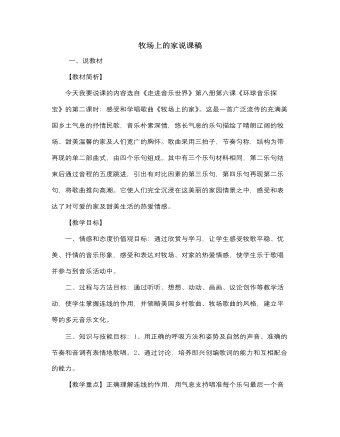
人音版小学音乐五年级上册牧场上的家说课稿
朴素深情悠长气息松散的节奏晴朗辽阔甜美温馨宽广的胸怀5、当学生唱两三次后,歌词就唱得较熟了,这时可以启发学生处理好歌曲中A乐句与B乐句的演唱力度,唱出mf与mp的力度对比。还可以启发他们用不同的演唱形式来表现音乐。6、教师范唱,最后全班用高位置的混声和圆润的音色来深情地演唱歌曲《牧场上的家》,尽情地表达对家乡的热爱。7、展示评价三、第三环节:拓展创编歌词(10分钟)听中编。同学们自编歌词,尽情歌唱自己的家。如:“猎德的家”、“我的家”、等。引导学生可根据我校综合实践课程的特色来创编歌词,歌唱猎德村改造前后的变化或心理感受。这时采用示范的方式展示和演唱老师创作的歌词,再让小组讨论并展示,还可让他们加上自制的打击乐器伴奏。最后是中肯的评价。
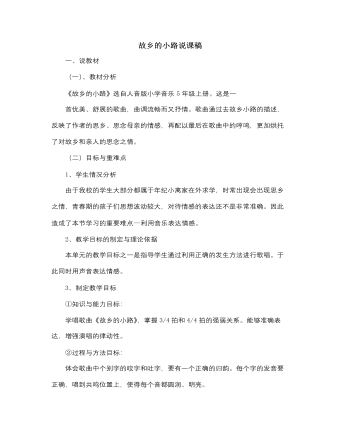
人音版小学音乐五年级上册故乡的小路说课稿
另外,歌曲中的“路”、“福”、“诉”、“咐”、“住”每个字发音要准确,要竖起来,并送到共鸣腔体里,唱到位置上,使每个音都圆润,明亮。4、在处理歌曲情感时,我首先采用了朗读法,学生更能够深切体会音乐的情绪。其次我还采用了画旋律线的方法,让学生能够更直观的感受到歌曲连绵流畅旋律,体验歌曲的情绪是随着音高起伏而变化的。第五环节:拓展延伸这个环节主要是情感的升华,教师设计播放歌曲《月之故乡》以此唤起学生思乡情绪,进行艺术熏陶,感受音乐中的情与美,浅谈自己的感受。第六环节:结束语(小结)通过本课的学习我们学习了3/4拍和4/4拍,掌握了拍子本身的强弱关系。同时学习了变化音#4在歌曲中的演唱技巧。希望我们可以一共去感受作者的思乡之情,同时让我们寻找到另外一种表达情感的方式—歌唱。
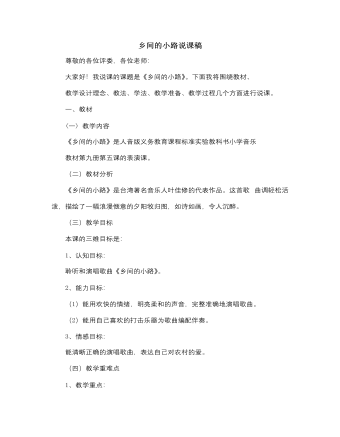
人音版小学音乐五年级上册乡间的小路说课稿
再让学生用“啦”字哼唱歌谱,让学生学会自主学习。跟琴哼唱歌词。结尾句处理(渐弱)注重细节,突出重难点。学会歌曲后做情感处理:在悠扬的音乐声中播放视频乡间的小路,看有哪些景物,对比身处乡间和城市的环境,引导学生用轻松愉快的声音演唱。完整、熟练地演唱歌曲。(轻松富有弹性的声音和高位置唱)。接下来我用竹笛演奏《乡间的小路》,让学生理解、体验和感受不同的乡村风格。 最后让学生带着感情演唱全曲,要注意指导学生体会歌曲的演唱情绪,强调演唱声音要自然、圆润、轻柔。3、表演歌曲学会歌曲后,学生分组,用不同的演唱形式处理歌曲。如:对唱、表演唱、小合唱等。教师对每组的表现做鼓励性评价。让他们“动”起来,并融入到歌曲意境中去,更好的理解歌曲。
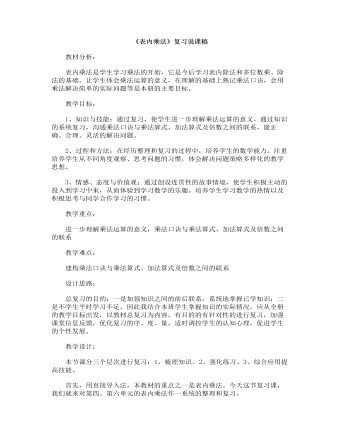
小学数学人教版二年级上册《表内乘法》复习说课稿
教学目标:1、知识与技能:通过复习,使学生进一步理解乘法运算的意义。通过知识的系统复习,沟通乘法口诀与乘法算式、加法算式及倍数之间的联系,能正确、合理、灵活的解决问题。2、过程和方法:在经历整理和复习的过程中,培养学生的数学能力。注重培养学生从不同角度观察、思考问题的习惯,体会解决问题策略多样化的教学思想。3、情感、态度与价值观:通过创设连贯性的故事情境,使学生积极主动的投入到学习中来,从而体验到学习数学的乐趣。培养学生学习数学的热情以及积极思考与同学合作学习的习惯。教学重点:进一步理解乘法运算的意义,乘法口诀与乘法算式、加法算式及倍数之间的联系教学难点:建构乘法口诀与乘法算式、加法算式及倍数之间的联系
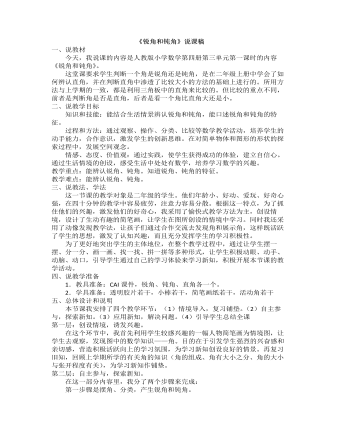
小学数学人教版二年级上册《认识锐角和钝角》说课稿
二、说教学目标知识和技能:能结合生活情景辨认锐角和钝角,能口述锐角和钝角的特征。 过程和方法:通过观察、操作、分类、比较等数学教学活动,培养学生的动手能力,合作意识,激发学生的创新思维。在对简单物体和图形的形状的探索过程中,发展空间观念。情感、态度、价值观:通过实践,使学生获得成功的体验,建立自信心。通过生活情境的创设,感受生活中处处有数学,培养学习数学的兴趣。教学重点:能辨认锐角、钝角。知道锐角、钝角的特征。教学难点:能辨认锐角、钝角。三、说教法、学法这一节课的教学对象是二年级的学生。他们年龄小、好动、爱玩、好奇心强,在四十分钟的教学中容易疲劳,注意力容易分散。根据这一特点,为了抓住他们的兴趣,激发他们的好奇心,我采用了愉快式教学方法为主,创设情境,设计了生动有趣的简笔画,让学生在图所创设的情境中学习。同时我还采用了动像发现教学法,让孩子们通过合作交流去发现角和展示角,这样既活跃了学生的思想,激发了认知兴趣,而且充分发挥学生的学习积极性。
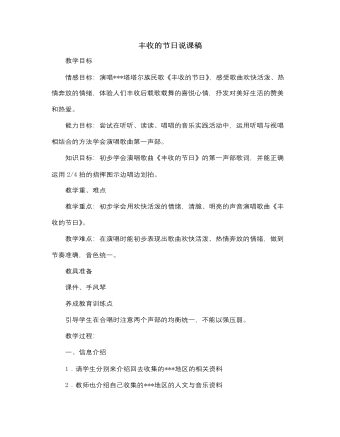
人音版小学音乐五年级上册丰收的节日说课稿
教学目标情感目标:演唱***塔塔尔族民歌《丰收的节日》,感受歌曲欢快活泼、热情奔放的情绪,体验人们丰收后载歌载舞的喜悦心情,抒发对美好生活的赞美和热爱。能力目标:尝试在听听、读读、唱唱的音乐实践活动中,运用听唱与视唱相结合的方法学会演唱歌曲第一声部。知识目标:初步学会演唱歌曲《丰收的节日》的第一声部歌词,并能正确运用2/4拍的指挥图示边唱边划拍。教学重、难点 教学重点:初步学会用欢快活泼的情绪,清脆、明亮的声音演唱歌曲《丰收的节日》。 教学难点:在演唱时能初步表现出歌曲欢快活泼、热情奔放的情绪,做到节奏准确,音色统一。 教具准备课件、手风琴养成教育训练点引导学生在合唱时注意两个声部的均衡统一,不能以强压弱。